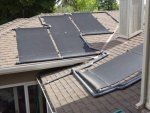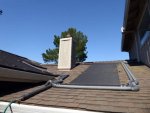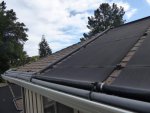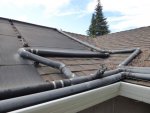I have a FAFCO solar system installed about 7 years ago. I am quite a newbie at pool maintenance, but I think I'll be forced to learn and do things myself because the local recommended FAFCO company/installer that we used is not trustworthy or reliable, and is extremely expensive.
What does a Vacuum Release Valve sound like when it is correctly operating, and is there a way to test it? I remember it used to make this sucking noise when the pool pump turned off. We started having leaking from our solar pipes/panels at night. It didn't leak during the day or when the pool pump was working, but in the in the middle of the night, water would leak out of the pipes or panels or somewhere, and we'd have a puddle of wet in the corner where the gutters dumped. I could see wetness on the roof in the morning. But, the leaking started at different times at night, and the wet places were coming from different areas. I have resorted to manually releasing/returning the water to the pool each night to prevent this water from getting out. The noise from the VRV was different (less sucking?) so we thought that might be the problem. We purchased a new one online and replaced it, but it doesn't seem to make any noise. I don't know if the sucking noise is something we are suppose to be hearing (indicating a good VRV), or how do I test the VRV? Do we have to turn 'on' the VRV somehow, or oil it, or something? I know I sound like a complete idiot, but I feel like one. Is it suppose to sound like sucking/noise when it is working? I have no idea if the new one we purchased was actually good, or if the old one was still good and this problem is for a different reason, or what. It's possible it was leaking even when the VRV was making the sucking noise, and we just didn't notice the puddle of water until much later.
I'd like to get this problem fixed. Yes, a reasonably priced pool professional would be ideal, but there are none out here in the San Jose CA Bay Area that I trust. Everyone who owns a pool that I know either does the work/troubleshooting themselves, or grudgingly uses someone but can't recommend them.
This is the biggest problem of the pool right now, we have a bunch of little issues too . I just want to fix this so I don't have to be manually releasing the water every night.
. I just want to fix this so I don't have to be manually releasing the water every night.
Thanks for any help that anyone can give!
What does a Vacuum Release Valve sound like when it is correctly operating, and is there a way to test it? I remember it used to make this sucking noise when the pool pump turned off. We started having leaking from our solar pipes/panels at night. It didn't leak during the day or when the pool pump was working, but in the in the middle of the night, water would leak out of the pipes or panels or somewhere, and we'd have a puddle of wet in the corner where the gutters dumped. I could see wetness on the roof in the morning. But, the leaking started at different times at night, and the wet places were coming from different areas. I have resorted to manually releasing/returning the water to the pool each night to prevent this water from getting out. The noise from the VRV was different (less sucking?) so we thought that might be the problem. We purchased a new one online and replaced it, but it doesn't seem to make any noise. I don't know if the sucking noise is something we are suppose to be hearing (indicating a good VRV), or how do I test the VRV? Do we have to turn 'on' the VRV somehow, or oil it, or something? I know I sound like a complete idiot, but I feel like one. Is it suppose to sound like sucking/noise when it is working? I have no idea if the new one we purchased was actually good, or if the old one was still good and this problem is for a different reason, or what. It's possible it was leaking even when the VRV was making the sucking noise, and we just didn't notice the puddle of water until much later.
I'd like to get this problem fixed. Yes, a reasonably priced pool professional would be ideal, but there are none out here in the San Jose CA Bay Area that I trust. Everyone who owns a pool that I know either does the work/troubleshooting themselves, or grudgingly uses someone but can't recommend them.
This is the biggest problem of the pool right now, we have a bunch of little issues too
Thanks for any help that anyone can give!






